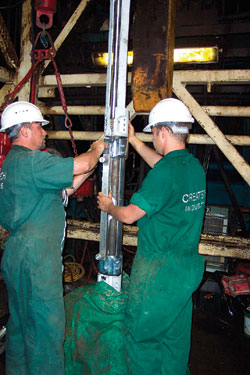 |
France |
|
Hydraulic fracturing monitoring aids in optimizing recovery
Thierry Bovier-Lapierre, Sercel Downhole Division, Paris
Micro-seismic activity indicates mechanical instabilities in rock formations, such as those induced by hydraulic fracturing stimulation. Knowledge of the orientation and extension of hydraulic fractures is essential for selecting well locations, to understand and improve fracture treatments – thus to optimize drainage between wells – to enhance recovery process efficiency, and to assess reservoir and cap-rock integrity during stimulation.
 |
Three successful hydraulic fracturing monitoring jobs were carried out at different sites for Mexico’s Pemex.
|
|
Sercel’s Downhole Division has identified fracture mapping, using induced micro-seismic monitoring, as the most promising technique to measure fracture orientation and extension.
Monitoring from the treatment well. This technique allows the critical advantage of being very close to the fracture. It offers an optimum sensibility, and allows recording of both micro-seismic events propagated within the formation and polarized acoustic emissions propagated within the fluids. Orientation of the fracture can be derived from micro-seismic events localization through analysis of the P&S waves polarization and velocities, or from acoustic emissions polarization.
In the treatment well, the SERCEL tri-axis geophone is permanently installed on the completion tubing inside the casing. Designed according to completion specifications, it allows safe installation, particularly in highly deviated wells. It is positioned above the production packer, as close as possible to the fracture depth.
The geophone assembly, mounted on a bow spring blade, is anchored firmly inside the casing, free from tubing weight and isolated from tubing noise, thanks to dampers. The tool is connected with a mono-conductor cable attached to the tubing with protectors through the annulus, and the tubing hanger up to the surface and the wellhead outlet. The installation is similar to that of a downhole pressure gauge and is done during a workover.
A high data transmission rate feeds a PC-based monitoring system that includes automatic events detection, data acquisition and QC, using the company’s proprietary SEIS-NUM user-friendly software in local or remote mode.
Case history, Oman. The first permanent downhole data acquisition system, commingling geophones and Schlumberger pressure gauges, was installed in a treatment well. The program included seven production wells, with two fracturing levels, each.
Successful data recording was begun in May 2000 with deep (4,000 m) fracturing monitoring. This yielded very encouraging results (fractures orientation and geometry, indications on possible secondary fractures).
The program was based on a step-by-step approach, with each treatment well permanently instrumented to be used as an observation well during the monitoring in the next treatment well (when the distance allowed). The goal was a comprehensive, permanent installation, to be further used for permanent reservoir monitoring and other applications, such as 4D seismic. Micro-seismic data was used to improve the fracture design and the well locations.
Other case histories. During 2002, in the North Sea, 16 levels of permanent geophones were installed offshore with Schlumberger in a 3-km-long horizontal drain for water injection and fracturing monitoring.
In Mexico, during 2003, successful hydraulic fracturing monitoring jobs were carried out on three different sites. These jobs used tubing-conveyed geophones in treatment wells and wireline-type SAM43 geophones in observation wells.
The data obtained helped to provide a better understanding of the actual hydraulic fracturing process and reservoir behavior. Building up on this success, further projects are being planned on a larger scale. 
|




